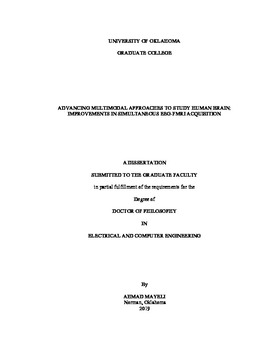| dc.description.abstract | The primary aim of the study detailed in this dissertation was improving the quality of simultaneous electroencephalography (EEG) and functional magnetic resonance imaging (fMRI) experiments. Two common challenges to use concurrent EEG-fMRI tests are addressed herein. The first is the presence of EEG artifacts during simultaneous EEG-fMRI, which require more consideration than EEG data recorded outside the scanner. To mitigate this issue, a fully automated artifact correction pipeline was developed. In the proposed pipeline, magnetic resonance (MR) environmental (i.e., gradient and ballistocardiogram [BCG]) artifacts were reduced using optimal basis sets (OBS) and average artifact subtraction (AAS). Subsequently, independent component analysis (ICA) was leveraged for reducing physiological artifacts (e.g., eye blinks, saccade and muscle artifacts), in addition to residual BCG artifacts. To validate pipeline performance, both resting-state (time/frequency and frequency analysis) and task-based (event related potential [ERP]) EEG data from eight healthy participants were tested. This data was compared with the time/frequency and frequency results achieved by matching meticulously, manually corrected EEG data to the automatically corrected EEG data. No significant difference was found between results. A comparison between ERP results (e.g., amplitude measures and SNR) also showed no differences between manually corrected and fully automated EEG corrected data. The second challenge addressed in this work is the low experimental control over the subject's actual behavior during the eyes-open resting-state fMRI (rsfMRI). This technique has been widely used for studying the (presumably) awake and alert human brain using multimodal EEG-fMRI; however, objective and verified experimental measures to quantify the degree of alertness (e.g., vigilance) are not readily available. To this end, the study reported in this dissertation investigated whether simultaneous multimodal EEG, rsfMRI and eye-tracker experiments could be used to extract objective and robust biomarkers of vigilance in healthy human subjects (n = 10) during cross fixation. Frontal and occipital beta power (FOBP) were found to correlate (r = 0.306, p<0.001) with pupil size fluctuation, which is an indirect index for locus coeruleus activity implicated in vigilance regulation. Moreover, FOBP was also correlated with heart rate (r = 0.255, p<0.001) and several brain regions in an anti-correlated network, including the bilateral insula and inferior parietal lobule. Results support the conclusion that FOBP is an objective and robust biomarker of vigilance in healthy human subjects. | en_US |
